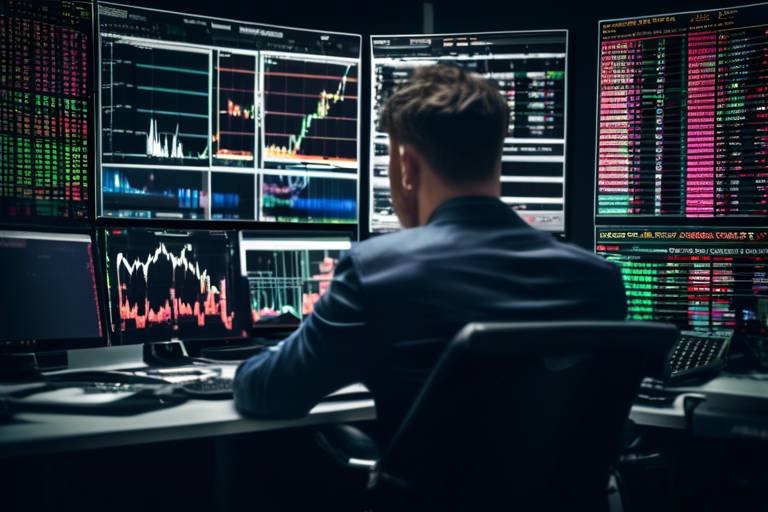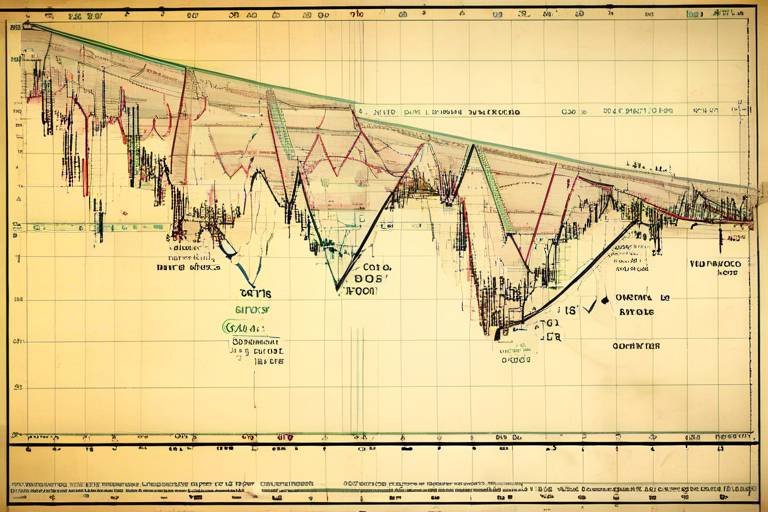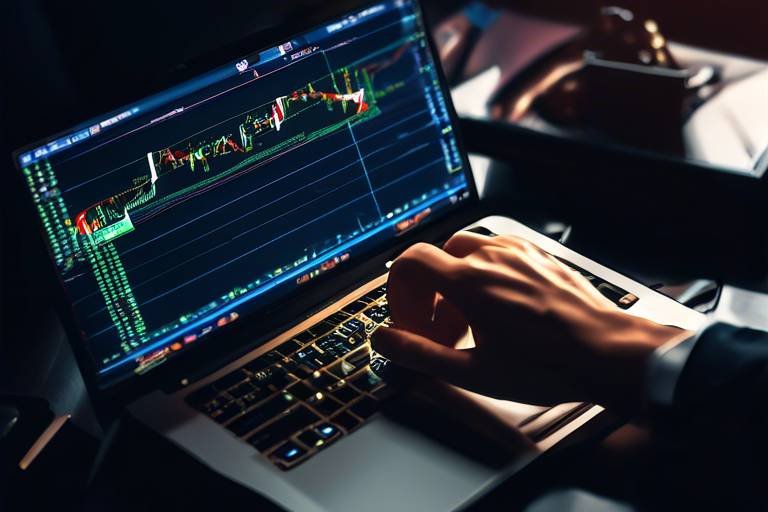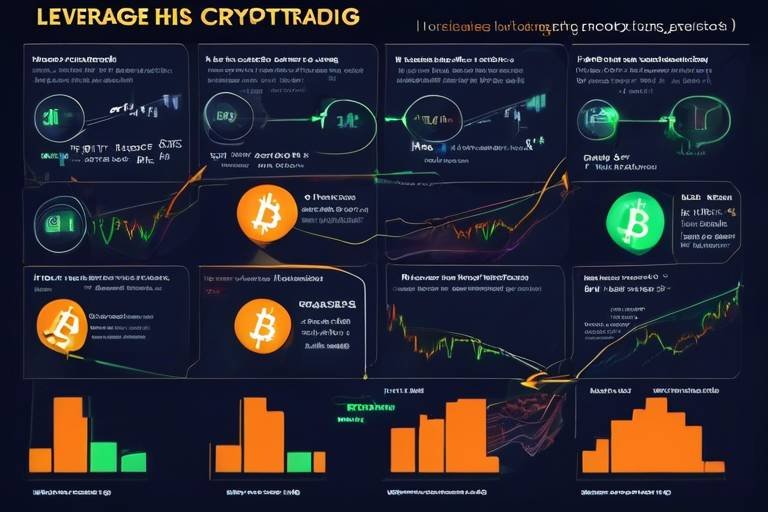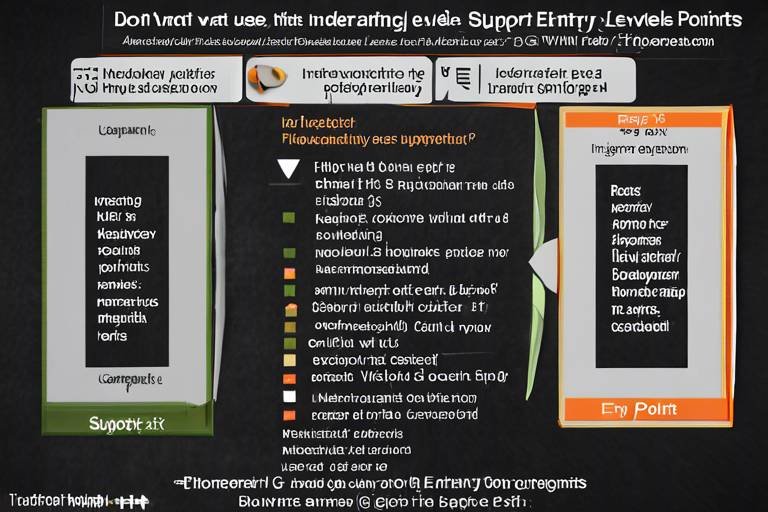How to Avoid Common Mistakes in Crypto Trading
Entering the world of cryptocurrency trading can feel like stepping into a high-stakes game where the rules are constantly changing. With prices that can swing wildly in the blink of an eye, it’s crucial to arm yourself with the right knowledge and strategies to avoid common pitfalls. This article explores key strategies and insights to help traders navigate the volatile world of cryptocurrency, minimizing errors and maximizing potential gains.
Grasping the nature of market volatility is crucial for crypto traders. The cryptocurrency market is notorious for its price fluctuations, which can be both a blessing and a curse. Imagine a roller coaster: one moment you're soaring high, and the next, you're plunging down. This unpredictable nature can impact your trading decisions significantly. When prices are soaring, it might be tempting to dive in, but if you're not careful, you could find yourself on the losing end when the market takes a downturn. Understanding these fluctuations helps you make informed decisions, allowing you to ride the waves of volatility rather than being tossed around by them.
Establishing achievable trading goals is essential for success. Think of your trading journey as a marathon, not a sprint. In this fast-paced world, it's easy to get caught up in the excitement and set unrealistic expectations. However, by setting realistic goals, you can manage your expectations and enhance your trading performance. For instance, instead of aiming to double your investment in a week, consider setting a more attainable goal, such as a 10% return over a month. This approach not only helps maintain your motivation but also reduces the risk of making impulsive decisions driven by greed.
Effective risk management is vital in crypto trading. Without it, even the most promising trades can turn into losses. Think of risk management as your safety net; it protects you when things go awry. Here are a few strategies to safeguard your investments:
- **Diversification**: Don’t put all your eggs in one basket. Spread your investments across different cryptocurrencies to mitigate risks.
- **Stop-Loss Orders**: Set stop-loss orders to automatically sell your assets if they drop to a certain price, limiting your losses.
- **Position Sizing**: Determine how much of your capital to risk on each trade based on your overall portfolio size.
By implementing these strategies, you can navigate the turbulent waters of crypto trading with greater confidence.
Selecting a reliable cryptocurrency exchange can significantly influence your trading success. Not all exchanges are created equal, and choosing the wrong one can lead to unnecessary headaches. When selecting an exchange, consider the following factors:
- **Security**: Look for exchanges with strong security measures in place to protect your funds.
- **Fees**: Be aware of the trading fees, withdrawal fees, and any other hidden costs.
- **User Experience**: A user-friendly interface can make your trading experience much smoother.
- **Customer Support**: Reliable customer service is crucial, especially when you encounter issues.
By taking the time to research and choose the right exchange, you can set yourself up for a more successful trading experience.
Technical analysis is a powerful tool in crypto trading. It’s like having a map in a dense forest; it guides you through the chaos of price movements. By analyzing historical price data and identifying patterns, you can make more informed trading decisions. For beginners, it might seem daunting, but once you grasp the basics, you'll find it invaluable. Key indicators to look out for include:
- **Moving Averages**: Help smooth out price data to identify trends.
- **Relative Strength Index (RSI)**: Indicates whether a cryptocurrency is overbought or oversold.
- **Volume**: Shows how much of a cryptocurrency is being traded, which can indicate strength or weakness in a trend.
Understanding these tools can give you a significant edge in the market.
Emotional trading can lead to poor decision-making, often resulting in losses. It’s like driving a car while distracted; you’re more likely to crash. To maintain discipline while trading, consider implementing the following techniques:
- **Set Clear Rules**: Establish a trading plan and stick to it, regardless of market emotions.
- **Take Breaks**: If you feel overwhelmed, step back and take a break. Clear your mind before making any decisions.
- **Practice Mindfulness**: Techniques such as meditation can help you stay calm and focused.
By managing your emotions, you can make more rational decisions and improve your trading outcomes.
Staying informed about market news and trends is imperative for traders. The crypto landscape is constantly evolving, and being in the know can help you anticipate market movements. Consider following reputable news sources and engaging with the community on social media platforms. Continuous learning is key in this fast-paced environment; it’s like being a detective, piecing together clues to make informed decisions.
Reflecting on past trading mistakes can provide valuable lessons. Every trader, no matter how experienced, has made errors. Instead of dwelling on them, analyze what went wrong and how you can improve in the future. Keeping a trading journal can be an excellent way to track your decisions and outcomes, allowing you to learn from your experiences and refine your strategies.
Various trading tools can enhance decision-making and efficiency. From charting software to automated trading bots, these resources can help you stay ahead of the curve. Consider using tools like:
- **Portfolio Trackers**: To keep an eye on your investments.
- **Charting Platforms**: For in-depth technical analysis.
- **News Aggregators**: To stay updated on market developments.
By leveraging these tools, you can streamline your trading process and make more informed decisions.
Q: What is the best strategy for beginners in crypto trading?
A: Start with a solid understanding of market volatility, set realistic goals, and practice effective risk management. Remember, patience is key!
Q: How can I avoid emotional trading?
A: Establish a trading plan, take breaks when needed, and practice mindfulness techniques to help maintain discipline.
Q: What tools should I use for crypto trading?
A: Utilize portfolio trackers, charting platforms, and news aggregators to enhance your trading efficiency and decision-making.

Understanding Market Volatility
Grasping the nature of market volatility is crucial for anyone diving into the world of cryptocurrency trading. Unlike traditional markets, where fluctuations might be measured in percentage points over weeks, the crypto market can swing wildly within minutes. Imagine riding a rollercoaster that suddenly drops at unexpected turns—that’s the crypto market for you! These rapid price changes can significantly impact your trading decisions and strategies, making it essential to understand what drives these fluctuations.
Market volatility is influenced by various factors, including market sentiment, news events, and trading volume. For instance, when a major news story breaks—whether it's regulatory changes, technological advancements, or even celebrity endorsements—the market can react almost instantaneously. Traders often find themselves caught off guard, leading to panic selling or exuberant buying. Understanding these dynamics can help you anticipate potential market movements and make more informed decisions.
Furthermore, it’s important to recognize that volatility isn’t inherently bad. In fact, it can present opportunities for profit. However, it also comes with risks. To navigate this landscape effectively, traders should consider the following:
- Stay Informed: Keeping up with the latest news and trends can help you anticipate price movements.
- Use Stop-Loss Orders: These can help mitigate losses by automatically selling your assets at a predetermined price.
- Practice Patience: Sometimes, the best decision is to wait for the right moment rather than jumping in during a volatile situation.
Ultimately, understanding market volatility is about finding a balance between risk and reward. Just like a skilled surfer rides the waves, a savvy trader learns to navigate the ups and downs of the market. By embracing volatility and developing a strategy that accounts for it, you can position yourself to not only survive but thrive in the unpredictable world of cryptocurrency trading.

Setting Realistic Goals
When diving into the thrilling world of crypto trading, one of the most crucial steps you can take is to set realistic goals. Think of it as charting a course before embarking on a journey. Without a clear destination, you might find yourself lost in the tumultuous waves of market fluctuations. Setting achievable goals not only helps in managing expectations but also enhances your overall trading performance. So, how do you go about this?
First, it’s essential to understand that the crypto market is notoriously volatile. Prices can swing dramatically within hours, and while this presents exciting opportunities, it can also lead to impulsive decisions if you aren't grounded. By establishing specific, measurable, achievable, relevant, and time-bound (SMART) goals, you can navigate this uncertain terrain with greater confidence. For instance, instead of saying, "I want to make money in crypto," a more realistic goal would be, "I aim to achieve a 10% return on my investment over the next three months." This clarity provides a roadmap for your trading strategies.
Moreover, consider breaking down your larger goals into smaller, manageable milestones. This approach not only makes the process less overwhelming but also allows you to celebrate small victories along the way. Imagine you're training for a marathon; you wouldn't just wake up one day and run 26.2 miles. You would start with shorter distances, gradually building your endurance. Similarly, in crypto trading, you could set weekly or monthly targets that contribute to your overall objective.
Another critical aspect of setting goals is to align them with your risk tolerance. Are you a risk-taker, or do you prefer a more conservative approach? By understanding your comfort level with risk, you can tailor your goals accordingly. For example, if you’re risk-averse, you might aim for more modest gains while focusing on protecting your capital. On the other hand, if you thrive on high stakes, you might set more ambitious targets, but always with a plan to manage potential losses.
Finally, it’s important to regularly review and adjust your goals as needed. The crypto landscape is ever-evolving, and what seemed like a realistic goal last month might no longer be feasible. By staying flexible and adapting your objectives based on market conditions and personal experiences, you can maintain a clear focus and continue progressing towards your trading aspirations.
In summary, setting realistic goals in crypto trading is all about being strategic and self-aware. By establishing clear objectives, breaking them down into manageable steps, aligning them with your risk tolerance, and remaining adaptable, you can significantly enhance your trading experience. Remember, it’s not just about the destination; it’s about enjoying the journey and learning along the way.
- What are SMART goals in crypto trading? SMART goals are Specific, Measurable, Achievable, Relevant, and Time-bound objectives that help traders focus their efforts and measure their success.
- How often should I review my trading goals? It’s advisable to review your trading goals regularly, ideally on a monthly basis, to ensure they remain relevant and achievable based on current market conditions.
- Can I change my goals if the market changes? Absolutely! Flexibility is key in trading. Adjust your goals based on market trends and your personal experiences to stay aligned with your trading strategy.

Risk Management Strategies
In the unpredictable world of cryptocurrency trading, having a solid risk management strategy is not just a good idea; it's essential for survival. Imagine setting sail on a vast ocean without a map or compass—it's easy to get lost or end up in treacherous waters. The same goes for trading. Without a clear plan for managing risk, you could find yourself facing significant losses that could wipe out your investments.
One of the first steps in crafting an effective risk management strategy is to determine how much of your total capital you're willing to risk on a single trade. A common rule of thumb is to never risk more than 1-2% of your trading capital on any one trade. This approach ensures that even if you encounter a series of losses, you still have enough capital to continue trading and recover your losses.
Another critical aspect of risk management is setting stop-loss orders. A stop-loss order is a predetermined price at which you'll exit a trade to prevent further losses. For example, if you buy a cryptocurrency at $100 and set a stop-loss at $90, your position will automatically close if the price drops to that level. This strategy helps you limit your losses and protects your overall capital.
Moreover, diversifying your portfolio can significantly reduce risk. By spreading your investments across different cryptocurrencies, you can mitigate the impact of a poor-performing asset. Think of it like a fruit basket; if one type of fruit spoils, you still have others to enjoy. This way, even if one cryptocurrency crashes, the others may still perform well, cushioning the blow to your overall portfolio.
Additionally, consider employing position sizing techniques. This involves adjusting the size of your trades based on your confidence in a particular asset and the associated risk. For instance, if you feel particularly bullish about a coin, you might allocate a larger portion of your capital to that trade, while being more conservative with assets you're less confident about.
To provide a clearer understanding, here’s a simple table that outlines some key risk management strategies:
| Strategy | Description |
|---|---|
| Risk per Trade | Limit risk to 1-2% of total capital. |
| Stop-Loss Orders | Automatically exit a trade to limit losses. |
| Diversification | Invest in multiple assets to spread risk. |
| Position Sizing | Adjust trade sizes based on confidence and risk. |
Lastly, it's essential to continuously evaluate and adjust your risk management strategies. The crypto market is dynamic, and what works today may not be effective tomorrow. Regularly reviewing your performance and learning from past trades will help you refine your approach and make better decisions in the future.
In conclusion, effective risk management is your lifeline in the volatile world of cryptocurrency trading. By implementing these strategies, you can protect your investments, minimize losses, and ultimately enhance your trading success. Remember, it's not just about making profits; it's about safeguarding your capital to trade another day.
- What is a stop-loss order? A stop-loss order is an instruction to sell an asset when it reaches a certain price, intended to limit losses.
- How much of my capital should I risk on a single trade? It's generally advisable to risk no more than 1-2% of your total trading capital on any single trade.
- Why is diversification important? Diversification helps spread risk across different assets, reducing the impact of poor performance from any single investment.
- How often should I review my risk management strategy? Regular reviews are crucial, especially in the fast-paced crypto market. Aim to evaluate your strategies after significant trades or market shifts.

Choosing the Right Exchange
When it comes to crypto trading, the choice of exchange can make or break your trading experience. Imagine you're a sailor navigating through turbulent waters; the exchange is your ship. If it’s sturdy and reliable, you’ll weather the storms and reach your destination. Conversely, a flimsy vessel can lead to disaster. Therefore, choosing the right exchange is fundamental for every trader, whether you're a novice or a seasoned pro.
First and foremost, you need to consider the security features of the exchange. In the wild world of cryptocurrencies, hacks and scams are all too common. Look for exchanges that offer two-factor authentication (2FA), cold storage for funds, and a solid track record of security. A quick glance at user reviews can provide insights into how well an exchange has handled security breaches in the past. After all, you wouldn’t want to hand your hard-earned assets to a platform that’s prone to leaks.
Another critical factor is the user interface. If you're new to trading, a complicated interface can be overwhelming. You want an exchange that is intuitive and user-friendly. Think of it like choosing a car; you wouldn’t want to drive a model that’s too complicated to handle. Look for exchanges that offer demo accounts or educational resources to help you get acquainted with their platform before diving in.
Additionally, consider the fees associated with trading on the platform. Different exchanges have different fee structures, including trading fees, withdrawal fees, and deposit fees. Some exchanges might offer lower trading fees but charge higher withdrawal fees, which can eat into your profits. It’s essential to read the fine print and understand how these fees will impact your trading strategy. A good way to visualize this is to create a comparison table of different exchanges, highlighting their fee structures:
| Exchange Name | Trading Fee | Withdrawal Fee | Deposit Fee |
|---|---|---|---|
| Exchange A | 0.25% | $1.00 | Free |
| Exchange B | 0.15% | $2.00 | Free |
| Exchange C | 0.20% | $0.50 | 1% of deposit |
Furthermore, liquidity is another pivotal aspect to consider. High liquidity means that you can buy or sell your assets quickly without causing significant price fluctuations. It’s like being at a busy intersection; the more traffic there is, the easier it is to navigate through. Exchanges with high liquidity will allow you to execute trades at your desired price more efficiently.
Lastly, don’t forget to check the available cryptocurrencies on the exchange. Some platforms offer a limited selection, while others boast a diverse range of altcoins. If you’re looking to diversify your portfolio or invest in lesser-known cryptocurrencies, ensure that the exchange supports those options. It’s akin to a restaurant menu; the more options you have, the better your chances of finding something you love.
In summary, choosing the right exchange is a multifaceted decision that requires careful consideration of various factors such as security, user interface, fees, liquidity, and available cryptocurrencies. By taking the time to research and evaluate your options, you’ll be setting yourself up for a smoother and more rewarding trading experience.
Q1: How do I know if an exchange is secure?
A1: Look for exchanges that offer two-factor authentication, cold storage for funds, and have a solid reputation in the community. Reading user reviews can also provide insights into their security practices.
Q2: What should I do if I find a better exchange after I've started trading?
A2: If you find a more suitable exchange, consider transferring your assets. However, be mindful of withdrawal fees and the time it may take to transfer your funds.
Q3: Can I use multiple exchanges for trading?
A3: Absolutely! Many traders use multiple exchanges to take advantage of different fee structures, liquidity levels, and available cryptocurrencies.
Q4: What is the best exchange for beginners?
A4: The best exchange for beginners often features a user-friendly interface, educational resources, and low fees. Research and compare several options to find the best fit for your needs.

Understanding Technical Analysis
When it comes to navigating the unpredictable waters of cryptocurrency trading, understanding technical analysis can be a game changer. Imagine trying to find your way through a dense fog without a map—this is what trading without technical analysis feels like. Technical analysis involves evaluating price movements and trading volumes through various tools and indicators to forecast future price trends. By analyzing historical data, traders can identify patterns that may suggest where the market is headed next.
So, how does this all work? Well, at its core, technical analysis relies on the premise that all relevant information is reflected in the price of a cryptocurrency. This means that by studying price charts, traders can glean insights about market sentiment and potential price movements. For instance, if a particular coin has been consistently climbing over the past few weeks, that upward trend could indicate strong buyer interest, suggesting that it might be a good time to invest.
One of the most common tools in technical analysis is the chart. There are several types of charts, but the most popular ones include:
- Line Charts: These show the closing prices over a period of time, making it easy to see the overall trend.
- Candlestick Charts: These provide more detail, showing the open, high, low, and close prices for a specific time frame, which can help identify market sentiment.
- Bar Charts: Similar to candlestick charts, but they represent price movements in a different format.
Beyond charts, there are also several key indicators that traders often use to inform their decisions. Some of the most popular include:
- Moving Averages: These help smooth out price data over a specific period, allowing traders to identify trends more easily.
- Relative Strength Index (RSI): This measures the speed and change of price movements, helping traders identify overbought or oversold conditions.
- MACD (Moving Average Convergence Divergence): This indicator helps traders spot changes in momentum by comparing two moving averages.
Understanding how to read these charts and indicators is crucial. However, it's equally important to remember that technical analysis is not foolproof. Like any tool, it has its limitations and should be used in conjunction with other strategies, including fundamental analysis and market sentiment. Think of it as a compass, guiding you in the right direction, but not guaranteeing a perfect path.
Moreover, the world of cryptocurrency is notoriously volatile. Prices can swing dramatically in a matter of hours, influenced by factors such as market news, regulatory changes, and even social media trends. Therefore, while technical analysis can provide valuable insights, it’s essential to remain adaptable and ready to adjust your strategies as new information arises.
In conclusion, mastering technical analysis can significantly enhance your trading prowess. By combining charting techniques with a solid understanding of indicators, you can position yourself to make more informed decisions in the ever-changing crypto landscape. Just remember, while it’s a powerful tool, it’s not a crystal ball—so always stay vigilant and keep learning!
- What is technical analysis in cryptocurrency trading? Technical analysis involves analyzing historical price data and trading volumes to forecast future price movements.
- Why is technical analysis important? It helps traders make informed decisions based on market trends and patterns, potentially increasing their chances of success.
- What are some common technical analysis tools? Popular tools include moving averages, RSI, and MACD, among others.
- Can technical analysis guarantee profits? No, while it can provide valuable insights, it does not guarantee success due to market volatility and other external factors.

Avoiding Emotional Trading
When it comes to crypto trading, emotions can be your worst enemy. Imagine standing on the edge of a cliff; one wrong step and you could plummet into a sea of losses. That’s what emotional trading feels like—a dangerous leap without a safety net. The thrill of the market can stir up feelings of excitement, fear, and greed, all of which can cloud your judgment and lead to poor decision-making. So, how do we keep our cool amidst the chaos? Let's dive into some effective techniques!
First off, it's essential to recognize your emotional triggers. Are you prone to panic selling when prices drop? Or do you tend to buy impulsively when you see others making profits? By identifying these patterns, you can develop strategies to counteract them. For instance, if you notice that your heart races when you see a sudden price change, take a step back and breathe. Remind yourself that the market is volatile and that knee-jerk reactions rarely lead to good outcomes.
Next, consider implementing a trading plan. A well-thought-out plan acts as your roadmap in the unpredictable landscape of crypto trading. It should outline your entry and exit points, risk tolerance, and profit targets. Having this plan in place can help you stick to your strategy, even when emotions threaten to derail you. Remember, a good plan is like a sturdy ship; it keeps you afloat when the waters get rough.
Additionally, employing tools like stop-loss orders can safeguard your investments. These orders automatically sell your assets when they reach a certain price, thereby limiting your losses and reducing the emotional burden of decision-making. Think of it as a safety net that catches you before you hit the ground. By setting these parameters, you can trade with more confidence, knowing that you have a buffer against emotional turmoil.
Another effective strategy is to practice mindfulness and emotional regulation techniques. Techniques such as meditation or deep breathing can help you stay grounded. When you feel the urge to make impulsive trades, take a moment to pause and reflect. Ask yourself, “Is this decision based on logic or emotion?” This simple question can help you regain clarity and make more rational choices.
Finally, it’s important to learn from your experiences. After each trading session, take some time to reflect on your decisions. Did you make trades based on fear or greed? What could you have done differently? Keeping a trading journal can be immensely helpful in this regard. Documenting your thoughts and feelings during trades not only helps you identify emotional patterns but also allows you to track your progress over time.
In summary, avoiding emotional trading is about self-awareness, planning, and reflection. By recognizing your triggers, sticking to a trading plan, utilizing stop-loss orders, practicing mindfulness, and learning from your experiences, you can navigate the tumultuous waters of crypto trading with a steadier hand. Remember, the goal is not just to survive the market but to thrive in it!
- What is emotional trading? Emotional trading refers to making trading decisions based on feelings rather than logic, often leading to impulsive actions.
- How can I control my emotions while trading? Implementing a trading plan, using stop-loss orders, and practicing mindfulness can help you manage your emotions effectively.
- Why is it important to avoid emotional trading? Emotional trading can lead to poor decision-making, resulting in significant financial losses and missed opportunities.
- What tools can help me in crypto trading? Trading plans, stop-loss orders, and trading journals are essential tools that can enhance your trading experience and help you avoid emotional pitfalls.

Keeping Up with News and Trends
In the fast-paced world of cryptocurrency, staying informed about the latest news and trends is not just a good idea—it's a necessity. Imagine trying to navigate a stormy sea without a compass; that’s what trading without current information feels like. The crypto market is notorious for its volatility, and news can send prices soaring or crashing within minutes. Whether it's regulatory changes, technological advancements, or major market events, being in the loop can make a significant difference in your trading outcomes.
One of the best ways to keep your finger on the pulse of the crypto world is by following reputable news sources. Websites like CoinDesk, CoinTelegraph, and CryptoSlate provide up-to-date information and in-depth analysis that can help you make informed decisions. Additionally, social media platforms like Twitter and Reddit can be invaluable for real-time updates and community insights. But beware! Not all information is created equal; it’s crucial to verify the credibility of your sources to avoid falling for misinformation.
Moreover, subscribing to newsletters from industry experts can be a game-changer. Think of it as having a personal guide through the chaotic landscape of crypto trading. These newsletters often provide curated content that highlights significant developments, market trends, and expert opinions, allowing you to absorb crucial information without getting overwhelmed.
Another effective strategy is to join online communities and forums where traders share their experiences and insights. Platforms like Discord and Telegram host numerous groups focused on specific cryptocurrencies or trading strategies. Engaging in discussions can not only broaden your knowledge but also help you understand how other traders are reacting to news events. Remember, the crypto community is vast and diverse, and learning from others can provide you with perspectives you might not have considered.
However, while it's essential to stay informed, it's equally important to avoid information overload. With the sheer volume of news available, it’s easy to get swept away by every headline. Focus on the news that directly impacts your trading strategy and portfolio. Prioritize understanding how specific events affect the market rather than trying to keep up with every single piece of information. This approach will help you maintain clarity and make more calculated decisions.
Lastly, consider using news aggregation tools that compile relevant articles and updates based on your interests. Platforms like Feedly or CryptoPanic allow you to customize your news feed, ensuring you receive only the most pertinent information. By filtering out the noise, you can concentrate on what truly matters to your trading strategy.
In summary, staying updated with news and trends is an essential component of successful crypto trading. By actively seeking out credible sources, engaging with the community, and utilizing technology to streamline your information intake, you can navigate the ever-changing landscape of cryptocurrency with confidence. Remember, knowledge is power, and in the world of crypto, it can be the difference between a successful trade and a costly mistake.
- How often should I check crypto news? It's best to check news at least once a day, but during high-volatility periods, more frequent checks may be necessary.
- What are some reliable sources for crypto news? Reputable sources include CoinDesk, CoinTelegraph, and CryptoSlate.
- Should I follow social media for crypto updates? Yes, but ensure you verify the credibility of the information before acting on it.
- How can I avoid information overload? Focus on news that directly impacts your trading strategy and use news aggregation tools to filter content.

Learning from Mistakes
In the fast-paced world of cryptocurrency trading, mistakes are not just common; they are almost inevitable. However, the key difference between successful traders and those who struggle lies in the ability to learn from these mistakes. Think of trading as a rollercoaster ride—there are exhilarating highs and nerve-wracking lows. Just like a rollercoaster, if you don’t buckle up and learn how to navigate the twists and turns, you might end up feeling queasy and lost.
Every trader has a story about a misstep that cost them dearly. Some may have jumped into a trade too quickly, driven by FOMO (fear of missing out), while others might have held onto a losing position for too long, hoping for a miraculous recovery. The important thing is to take a step back and analyze what went wrong. This is where self-reflection becomes your best friend.
To truly learn from your mistakes, consider keeping a trading journal. This doesn’t have to be anything fancy—just a simple document where you jot down your trades, the reasons behind them, and the outcomes. Over time, this journal will reveal patterns in your decision-making. For instance, you might notice that you tend to make rash decisions when the market is particularly volatile. Recognizing these patterns is the first step in making more informed choices in the future.
Here are some common mistakes traders often make, and how you can avoid them:
- Ignoring Market Research: Not doing your homework can lead to uninformed decisions. Make it a habit to research before you invest.
- Overtrading: Trading too frequently can lead to significant losses. Set clear criteria for entering and exiting trades.
- Failure to Set Stop-Loss Orders: Always use stop-loss orders to protect your capital. This is like wearing a seatbelt on that rollercoaster ride!
Another effective strategy is to engage with a community of traders. Sharing experiences and insights can provide valuable lessons that you might not have considered on your own. Whether it’s through online forums, social media groups, or local meetups, connecting with others in the crypto space can help you learn from their mistakes as well as your own.
Lastly, remember that the crypto market is constantly evolving. What worked yesterday might not work today. As such, it’s essential to stay adaptable and open to change. Embrace the learning curve, and don’t be afraid to adjust your strategies based on past experiences. After all, in the world of crypto trading, every mistake is a stepping stone toward becoming a more skilled and successful trader.
Q: How can I ensure I learn from my trading mistakes?
A: Keeping a trading journal is one of the best ways to track your decisions and outcomes. Reflect on your trades regularly to identify patterns and areas for improvement.
Q: Is it normal to make mistakes in crypto trading?
A: Absolutely! Mistakes are a part of the learning process. The key is to learn from them and not repeat them.
Q: How can I avoid emotional trading?
A: Establish a clear trading plan with specific entry and exit points. Stick to this plan, and use tools like stop-loss orders to help manage your emotions.
Q: Should I seek advice from other traders?
A: Yes! Engaging with a community of traders can provide valuable insights and help you learn from their experiences.

Utilizing Trading Tools
In the fast-paced world of crypto trading, having the right tools at your disposal can be the difference between success and failure. Just like a carpenter wouldn’t build a house without a hammer and nails, a trader shouldn’t enter the market without utilizing effective trading tools. These tools can help you analyze market trends, manage your portfolio, and execute trades more efficiently. So, what tools should you consider to enhance your trading experience?
First off, trading platforms are essential. These platforms provide you with a user-friendly interface to buy and sell cryptocurrencies. Some popular platforms include Binance, Coinbase, and Kraken. Each of these platforms offers unique features such as advanced charting tools, real-time market data, and different order types, which can significantly aid in making informed trading decisions.
Next, let’s talk about technical analysis tools. These tools help you analyze price movements and identify potential trading opportunities. For instance, software like TradingView or Coinigy allows you to create custom charts and apply various indicators such as Moving Averages, RSI, and MACD. By understanding these indicators, you can better predict market movements and time your trades more effectively. Here’s a quick overview of some commonly used technical indicators:
| Indicator | Description |
|---|---|
| Moving Average (MA) | Helps smooth out price action by filtering out the “noise” from random price fluctuations. |
| Relative Strength Index (RSI) | Measures the speed and change of price movements, typically used to identify overbought or oversold conditions. |
| Moving Average Convergence Divergence (MACD) | Shows the relationship between two moving averages of a security’s price, helping traders spot trends. |
Furthermore, portfolio management tools are crucial for tracking your investments and assessing your performance. Tools like Blockfolio or Delta allow you to monitor your cryptocurrency holdings, track their performance over time, and even receive alerts for price changes. With these tools, you can see at a glance how your portfolio is doing and make informed decisions about when to buy or sell.
Don’t forget about news aggregators! Staying updated with the latest news is vital in the crypto space. Platforms like CoinDesk and CryptoSlate provide real-time news updates and analysis, helping you stay ahead of the curve. The crypto market is heavily influenced by news events, and being informed can help you make timely trading decisions. Additionally, joining communities on platforms like Reddit or Telegram can provide valuable insights and discussions that can enhance your trading strategy.
Lastly, consider using trading bots. These automated tools can execute trades on your behalf based on predefined strategies. While they can be incredibly useful, it’s essential to choose a reputable bot and thoroughly understand its settings to avoid potential losses. Trading bots can help you take advantage of market opportunities even when you’re not actively monitoring the market.
In conclusion, utilizing the right trading tools can significantly enhance your trading experience and increase your chances of success in the volatile world of cryptocurrency. By investing time in learning how to use these tools effectively, you can make better decisions, manage your risks, and ultimately, improve your trading performance.
- What are trading tools? Trading tools are software and platforms that assist traders in analyzing the market, managing their investments, and executing trades.
- How do I choose the right trading platform? Consider factors like security, user interface, fees, and available features when selecting a trading platform.
- Can trading bots guarantee profits? No, trading bots cannot guarantee profits. They are based on algorithms and strategies, but market conditions can change rapidly.
- What is the importance of technical analysis? Technical analysis helps traders understand market trends and make informed decisions based on historical price movements.
Frequently Asked Questions
- What is market volatility and why is it important in crypto trading?
Market volatility refers to the rapid and significant price fluctuations that cryptocurrencies can experience. Understanding this volatility is crucial because it affects your trading decisions. If you can grasp how these changes occur, you can better navigate the ups and downs, ultimately leading to more informed trading strategies.
- How can I set realistic trading goals?
Setting realistic trading goals involves assessing your risk tolerance, time commitment, and market knowledge. Start by defining what you want to achieve, whether it's a specific profit target or learning a new trading strategy. Remember, these goals should be achievable and measurable to keep you motivated and on track.
- What are some effective risk management strategies in crypto trading?
Effective risk management strategies include diversifying your portfolio, setting stop-loss orders, and only investing what you can afford to lose. By implementing these strategies, you can protect your investments and minimize potential losses, which is essential in the unpredictable world of crypto.
- How do I choose the right cryptocurrency exchange?
When choosing a cryptocurrency exchange, consider factors like security, fees, user interface, and the variety of cryptocurrencies offered. Research user reviews and ensure the exchange complies with regulations to ensure a safe trading experience.
- What is technical analysis and why is it important?
Technical analysis involves using historical price data and trading volume to predict future price movements. It's important because it helps traders make informed decisions based on patterns and trends rather than emotions or speculation, leading to better trading outcomes.
- How can I avoid emotional trading?
To avoid emotional trading, establish a clear trading plan and stick to it. Use tools like stop-loss orders to limit potential losses and practice mindfulness techniques to manage stress. This discipline can help you make rational decisions rather than impulsive ones driven by fear or greed.
- Why is it important to stay updated on news and trends in crypto?
Staying updated on market news and trends is crucial because the cryptocurrency market can be heavily influenced by external factors like regulatory changes, technological advancements, and market sentiment. By being informed, you can make timely decisions that could significantly impact your trading success.
- How can I learn from my past trading mistakes?
Learning from past mistakes involves keeping a trading journal where you document your trades, including the rationale behind each decision. Analyzing your successes and failures will provide valuable insights that can help you refine your strategies and avoid repeating the same errors in the future.
- What trading tools should I consider using?
Essential trading tools include charting software, portfolio trackers, and news aggregators. These tools can enhance your decision-making process and efficiency, allowing you to stay informed and make better trades based on data and analysis.



